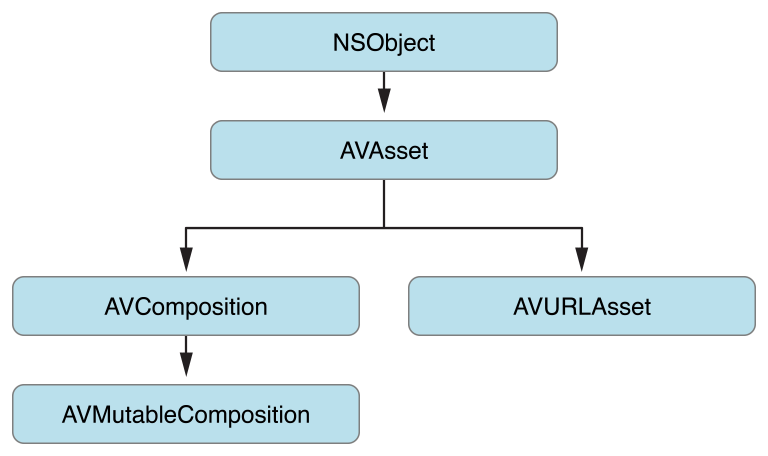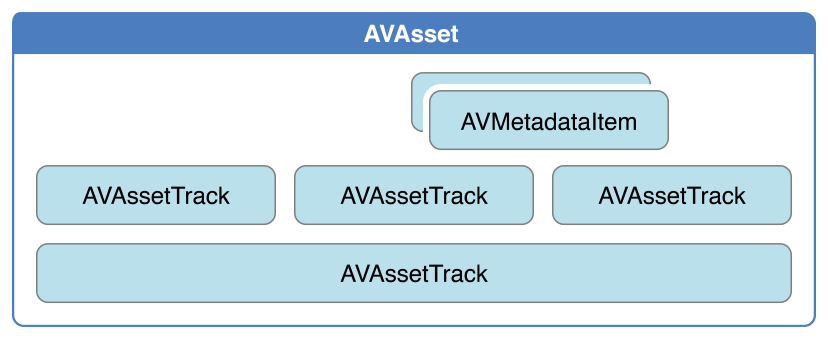Time and Media Representations
Time-based audiovisual data, such as a movie file or a video stream, is represented in the AV Foundation framework by AVAsset. Its structure dictates much of the framework works. Several low-level data structures that AV Foundation uses to represent time and media such as sample buffers come from the Core Media framework.
Representation of Assets
AVAsset is the core class in the AV Foundation framework. It provides a format-independent abstraction of time-based audiovisual data, such as a movie file or a video stream. The primary relationships are shown in Figure 6-1. In many cases, you work with one of its subclasses: You use the composition subclasses when you create new assets (see Editing), and you use AVURLAsset to create a new asset instance from media at a given URL (including assets from the MPMedia framework or the Asset Library framework—see Using Assets).

An asset contains a collection of tracks that are intended to be presented or processed together, each of a uniform media type, including (but not limited to) audio, video, text, closed captions, and subtitles. The asset object provides information about whole resource, such as its duration or title, as well as hints for presentation, such as its natural size. Assets may also have metadata, represented by instances of AVMetadataItem.
A track is represented by an instance of AVAssetTrack, as shown in Figure 6-2. In a typical simple case, one track represents the audio component and another represents the video component; in a complex composition, there may be multiple overlapping tracks of audio and video.

A track has a number of properties, such as its type (video or audio), visual and/or audible characteristics (as appropriate), metadata, and timeline (expressed in terms of its parent asset). A track also has an array of format descriptions. The array contains CMFormatDescription objects (see CMFormatDescriptionRef), each of which describes the format of media samples referenced by the track. A track that contains uniform media (for example, all encoded using to the same settings) will provide an array with a count of 1.
A track may itself be divided into segments, represented by instances of AVAssetTrackSegment. A segment is a time mapping from the source to the asset track timeline.
Representations of Time
Time in AV Foundation is represented by primitive structures from the Core Media framework.
CMTime Represents a Length of Time
CMTime is a C structure that represents time as a rational number, with a numerator (an int64_t value), and a denominator (an int32_t timescale). Conceptually, the timescale specifies the fraction of a second each unit in the numerator occupies. Thus if the timescale is 4, each unit represents a quarter of a second; if the timescale is 10, each unit represents a tenth of a second, and so on. You frequently use a timescale of 600, because this is a multiple of several commonly used frame rates: 24 fps for film, 30 fps for NTSC (used for TV in North America and Japan), and 25 fps for PAL (used for TV in Europe). Using a timescale of 600, you can exactly represent any number of frames in these systems.
In addition to a simple time value, a CMTime structure can represent nonnumeric values: +infinity, -infinity, and indefinite. It can also indicate whether the time been rounded at some point, and it maintains an epoch number.
Using CMTime
You create a time using CMTimeMake or one of the related functions such as CMTimeMakeWithSeconds (which allows you to create a time using a float value and specify a preferred timescale). There are several functions for time-based arithmetic and for comparing times, as illustrated in the following example:
CMTime time1 = CMTimeMake(200, 2); // 200 half-seconds |
CMTime time2 = CMTimeMake(400, 4); // 400 quarter-seconds |
// time1 and time2 both represent 100 seconds, but using different timescales. |
if (CMTimeCompare(time1, time2) == 0) { |
NSLog(@"time1 and time2 are the same"); |
} |
Float64 float64Seconds = 200.0 / 3; |
CMTime time3 = CMTimeMakeWithSeconds(float64Seconds , 3); // 66.66... third-seconds |
time3 = CMTimeMultiply(time3, 3); |
// time3 now represents 200 seconds; next subtract time1 (100 seconds). |
time3 = CMTimeSubtract(time3, time1); |
CMTimeShow(time3); |
if (CMTIME_COMPARE_INLINE(time2, ==, time3)) { |
NSLog(@"time2 and time3 are the same"); |
} |
For a list of all the available functions, see CMTime Reference.
Special Values of CMTime
Core Media provides constants for special values: kCMTimeZero, kCMTimeInvalid, kCMTimePositiveInfinity, and kCMTimeNegativeInfinity. There are many ways in which a CMTime structure can, for example, represent a time that is invalid. To test whether a CMTime is valid, or a nonnumeric value, you should use an appropriate macro, such as CMTIME_IS_INVALID, CMTIME_IS_POSITIVE_INFINITY, or CMTIME_IS_INDEFINITE.
CMTime myTime = <#Get a CMTime#>; |
if (CMTIME_IS_INVALID(myTime)) { |
// Perhaps treat this as an error; display a suitable alert to the user. |
} |
You should not compare the value of an arbitrary CMTime structure with kCMTimeInvalid.
Representing CMTime as an Object
If you need to use CMTime structures in annotations or Core Foundation containers, you can convert a CMTime structure to and from a CFDictionary opaque type (see CFDictionaryRef) using the CMTimeCopyAsDictionary and CMTimeMakeFromDictionary functions, respectively. You can also get a string representation of a CMTime structure using the CMTimeCopyDescription function.
Epochs
The epoch number of a CMTime structure is usually set to 0, but you can use it to distinguish unrelated timelines. For example, the epoch could be incremented through each cycle using a presentation loop, to differentiate between time N in loop 0 and time N in loop 1.
CMTimeRange Represents a Time Range
CMTimeRange is a C structure that has a start time and duration, both expressed as CMTime structures. A time range does not include the time that is the start time plus the duration.
You create a time range using CMTimeRangeMake or CMTimeRangeFromTimeToTime. There are constraints on the value of the CMTime epochs:
CMTimeRangestructures cannot span different epochs.The epoch in a
CMTimestructure that represents a timestamp may be nonzero, but you can only perform range operations (such asCMTimeRangeGetUnion) on ranges whose start fields have the same epoch.The epoch in a
CMTimestructure that represents a duration should always be 0, and the value must be nonnegative.
Working with Time Ranges
Core Media provides functions you can use to determine whether a time range contains a given time or other time range, to determine whether two time ranges are equal, and to calculate unions and intersections of time ranges, such as CMTimeRangeContainsTime, CMTimeRangeEqual, CMTimeRangeContainsTimeRange, and CMTimeRangeGetUnion.
Given that a time range does not include the time that is the start time plus the duration, the following expression always evaluates to false:
CMTimeRangeContainsTime(range, CMTimeRangeGetEnd(range)) |
For a list of all the available functions, see CMTimeRange Reference.
Special Values of CMTimeRange
Core Media provides constants for a zero-length range and an invalid range, kCMTimeRangeZero and kCMTimeRangeInvalid, respectively. There are many ways, though in which a CMTimeRange structure can be invalid, or zero—or indefinite (if one of the CMTime structures is indefinite. If you need to test whether a CMTimeRange structure is valid, zero, or indefinite, you should use an appropriate macro: CMTIMERANGE_IS_VALID, CMTIMERANGE_IS_INVALID, CMTIMERANGE_IS_EMPTY, or CMTIMERANGE_IS_EMPTY.
CMTimeRange myTimeRange = <#Get a CMTimeRange#>; |
if (CMTIMERANGE_IS_EMPTY(myTimeRange)) { |
// The time range is zero. |
} |
You should not compare the value of an arbitrary CMTimeRange structure with kCMTimeRangeInvalid.
Representing a CMTimeRange Structure as an Object
If you need to use CMTimeRange structures in annotations or Core Foundation containers, you can convert a CMTimeRange structure to and from a CFDictionary opaque type (see CFDictionaryRef) using CMTimeRangeCopyAsDictionary and CMTimeRangeMakeFromDictionary, respectively. You can also get a string representation of a CMTime structure using the CMTimeRangeCopyDescription function.
Representations of Media
Video data and its associated metadata are represented in AV Foundation by opaque objects from the Core Media framework. Core Media represents video data using CMSampleBuffer (see CMSampleBufferRef). CMSampleBuffer is a Core Foundation-style opaque type; an instance contains the sample buffer for a frame of video data as a Core Video pixel buffer (see CVPixelBufferRef). You access the pixel buffer from a sample buffer using CMSampleBufferGetImageBuffer:
CVPixelBufferRef pixelBuffer = CMSampleBufferGetImageBuffer(<#A CMSampleBuffer#>); |
From the pixel buffer, you can access the actual video data. For an example, see Converting CMSampleBuffer to a UIImage Object.
In addition to the video data, you can retrieve a number of other aspects of the video frame:
Timing information. You get accurate timestamps for both the original presentation time and the decode time using
CMSampleBufferGetPresentationTimeStampandCMSampleBufferGetDecodeTimeStamprespectively.Format information. The format information is encapsulated in a CMFormatDescription object (see
CMFormatDescriptionRef). From the format description, you can get for example the pixel type and video dimensions usingCMVideoFormatDescriptionGetCodecTypeandCMVideoFormatDescriptionGetDimensionsrespectively.Metadata. Metadata are stored in a dictionary as an attachment. You use
CMGetAttachmentto retrieve the dictionary:CMSampleBufferRef sampleBuffer = <#Get a sample buffer#>;
CFDictionaryRef metadataDictionary =
CMGetAttachment(sampleBuffer, CFSTR("MetadataDictionary", NULL);if (metadataDictionary) {// Do something with the metadata.
}
Converting CMSampleBuffer to a UIImage Object
The following code shows how you can convert a CMSampleBuffer to a UIImage object. You should consider your requirements carefully before using it. Performing the conversion is a comparatively expensive operation. It is appropriate to, for example, create a still image from a frame of video data taken every second or so. You should not use this as a means to manipulate every frame of video coming from a capture device in real time.
// Create a UIImage from sample buffer data |
- (UIImage *) imageFromSampleBuffer:(CMSampleBufferRef) sampleBuffer |
{ |
// Get a CMSampleBuffer's Core Video image buffer for the media data |
CVImageBufferRef imageBuffer = CMSampleBufferGetImageBuffer(sampleBuffer); |
// Lock the base address of the pixel buffer |
CVPixelBufferLockBaseAddress(imageBuffer, 0); |
// Get the number of bytes per row for the pixel buffer |
void *baseAddress = CVPixelBufferGetBaseAddress(imageBuffer); |
// Get the number of bytes per row for the pixel buffer |
size_t bytesPerRow = CVPixelBufferGetBytesPerRow(imageBuffer); |
// Get the pixel buffer width and height |
size_t width = CVPixelBufferGetWidth(imageBuffer); |
size_t height = CVPixelBufferGetHeight(imageBuffer); |
// Create a device-dependent RGB color space |
CGColorSpaceRef colorSpace = CGColorSpaceCreateDeviceRGB(); |
// Create a bitmap graphics context with the sample buffer data |
CGContextRef context = CGBitmapContextCreate(baseAddress, width, height, 8, |
bytesPerRow, colorSpace, kCGBitmapByteOrder32Little | kCGImageAlphaPremultipliedFirst); |
// Create a Quartz image from the pixel data in the bitmap graphics context |
CGImageRef quartzImage = CGBitmapContextCreateImage(context); |
// Unlock the pixel buffer |
CVPixelBufferUnlockBaseAddress(imageBuffer,0); |
// Free up the context and color space |
CGContextRelease(context); |
CGColorSpaceRelease(colorSpace); |
// Create an image object from the Quartz image |
UIImage *image = [UIImage imageWithCGImage:quartzImage]; |
// Release the Quartz image |
CGImageRelease(quartzImage); |
return (image); |
} |
Copyright © 2015 Apple Inc. All Rights Reserved. Terms of Use | Privacy Policy | Updated: 2015-06-30